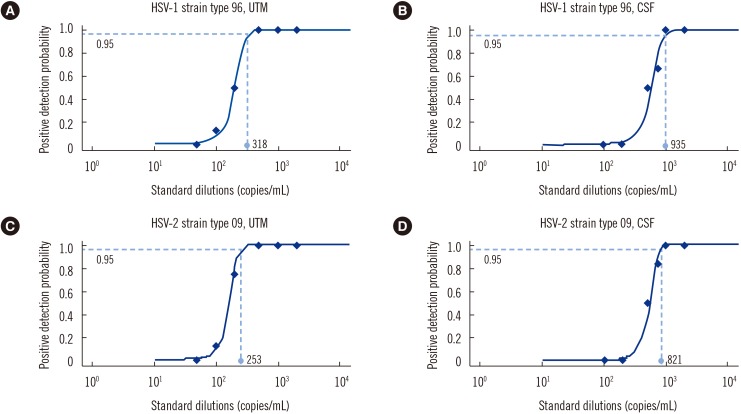1. Gupta R, Warren T, Wald A. Genital herpes. Lancet. 2007; 370:2127–2137. PMID:
18156035.
2. Kimberlin DW, Rouse DJ. Clinical practice. Genital herpes. N Engl J Med. 2004; 350:1970–1977. PMID:
15128897.
4. Wald A. Herpes simplex virus type 2 transmission: risk factors and virus shedding. Herpes. 2004; 11(Suppl 3):130A–137A.
5. Wald A, Zeh J, Selke S, Warren T, Ryncarz AJ, Ashley R, et al. Reactivation of genital herpes simplex virus type 2 infection in asymptomatic seropositive persons. N Engl J Med. 2000; 342:844–850. PMID:
10727588.
6. Eskild A, Jeansson S, Stray-Pedersen B, Jenum PA. Herpes simplex virus type-2 infection in pregnancy: no risk of fetal death: results from a nested case-control study within 35,940 women. BJOG. 2002; 109:1030–1035. PMID:
12269678.
7. Kimberlin DW, Whitley RJ, Wan W, Powell DA, Storch G, Ahmed A, et al. Oral acyclovir suppression and neurodevelopment after neonatal herpes. N Engl J Med. 2011; 365:1284–1292. PMID:
21991950.
8. Ellerin TB, Walsh SR, Hooper DC. Recurrent meningitis of unknown aetiology. Lancet. 2004; 363:1772. PMID:
15172776.
9. Singh A, Preiksaitis J, Ferenczy A, Romanowski B. The laboratory diagnosis of herpes simplex virus infections. Can J Infect Dis Med Microbiol. 2005; 16:92–98. PMID:
18159535.
10. LeGoff J, Péré H, Bélec L. Diagnosis of genital herpes simplex virus infection in the clinical laboratory. Virol J. 2014; 11:83. PMID:
24885431.
11. Kowalski RP, Karenchak LM, Shah C, Gordon JS. ELVIS: a new 24-hour culture test for detecting herpes simplex virus from ocular samples. Arch Ophthamol. 2002; 120:960–962.
12. Miller NS, Yen-Lieberman B, Poulter MD, Tang YW, Granato PA. Comparative clinical evaluation of the IsoAmp® HSV assay with ELVIS® HSV culture/ID/typing test system for the detection of herpes simplex virus in genital and oral lesions. J Clin Virol. 2012; 54:355–358. PMID:
22613012.
13. Tong Y, McCarthy K, Kong H, Lemieux B. Development and comparison of a rapid isothermal nucleic acid amplification test for typing of herpes simplex virus types 1 and 2 on a portable fluorescence detector. J Mol Diag. 2012; 14:569–576.
14. Cone RW, Hobson AC, Brown Z, Ashley R, Berry S, Winter C, et al. Frequent detection of genital herpes simplex virus DNA by polymerase chain reaction among pregnant women. JAMA. 1994; 272:792–796. PMID:
8078144.
15. Young S, Body B, Moore F, Dunbar S. Multicenter evaluation of the Luminex® ARIES® HSV 1&2 Assay for the detection of herpes simplex virus types 1 and 2 in cutaneous and mucocutaneous lesion specimens. Expert Rev Mol Diagn. 2016; 16:1241–1249. PMID:
27771977.
16. Binnicker MJ, Espy MJ, Duresko B, Irish C, Mandrekar J. Automated processing, extraction and detection of herpes simplex virus types 1 and 2: a comparative evaluation of three commercial platforms using clinical specimens. J Clin Virol. 2017; 89:30–33. PMID:
28226272.
17. Tang JW, Lin M, Chiu L, Koay ES. Viral loads of herpes simplex virus in clinical samples–a 5-year retrospective analysis. J Med Virol. 2010; 82:1911–1916. PMID:
20872718.
18. Almeida SM, Raboni SM, Noqueira MB, Vidal LR. Red blood cells in cerebrospinal fluid as possible inhibitory factor for enterovirus RT-PCR. Arg Neuropsiquiatr. 2016; 74:810–815.
19. Ratnamohan VM, Cunningham AL, Rawlinson WD. Removal of inhibitors of CSF-PCR to improve diagnosis of herpesviral encephalitis. J Virol Methods. 1998; 72:59–65. PMID:
9672133.






 PDF
PDF ePub
ePub Citation
Citation Print
Print



 XML Download
XML Download